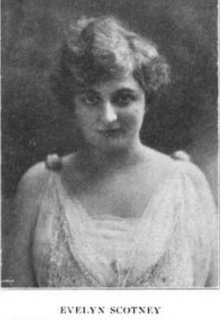Evelyn Scotney
Evelyn Scotney (11 July 1896 – 5 August 1967)[1] was an Australian coloratura soprano of great renown in the period from 1913 to the late 1920s. Her range extended to E in altissimo.[2] In her time she was considered by some to be the world's greatest soprano. She was compared very favourably with Amelita Galli-Curci, Luisa Tetrazzini and others.[3][4] Her recording of "Caro nome" from Verdi's Rigoletto was described by a critic as "one of the best soprano records in existence",[4] and her recording of The Blue Danube and other Strauss vocal waltzes was described as "absolutely perfect coloratura singing".[5] She appears in The Record of Singing.

Biography
Evelyn Scotney was born in Ballarat in 1896, to parents Henry Bailey Scotney and Eliza Scotney.[6] Her father was a professor from the University of Oxford who had come to Australia to study minerals, married there, and decided to stay.[2] Her family moved to Melbourne when she was young.[7] She studied singing there with Elise Wiedermann, who also taught Elsa Stralia, Florence Austral and others.[8] She was first noticed by Nellie Melba, while singing at a reception for Lord Kitchener in Melbourne. Melba sent her to Paris to study with her own teacher Mathilde Marchesi.[7][9] She later studied with Paolo Tosti in London. There she was heard by Henry Russell, the director of the Boston Opera Company, who engaged her to sing in Boston. She first appeared as La Charmeuse in Massenet's Thais,[10] then deputised for Luisa Tetrazzini in the title role of Donizetti's Lucia di Lammermoor, the Mad Scene from which became her most famous part.[2] In this and other roles she was said to surpass Tetrazzini.[11] Her other roles in Boston included Carmen and Olympia (The Tales of Hoffmann).[10] She also sang in Debussy's Le martyre de Saint Sébastien in 1912 with Jeska Swartz, conducted by André Caplet.[12]
Evelyn Scotney married Howard J. White, a bass singer with the company, and was then known as "Madame Scotney".[2] She later sang at the Metropolitan Opera in New York, in operas such as Rimsky-Korsakov's Le Coq d'Or,[13] Lucia di Lammermoor, L'elisir d'amore and the revival of Fromental Halévy's La Juive, in which she sang opposite Enrico Caruso.[7][14]
During World War I she had various tours of Australia with her husband.[15][16] Her only brother Henry died in 1915, aged 21.[6] She returned to the US after the war.[7] It was Evelyn Scotney who appeared opposite Enrico Caruso in his final performance, in La Juive, on Christmas Eve 1920.[17] She sang in Melbourne in 1923.[18] By 1925 she was singing Gilda (Rigoletto) in London.[19] She sang with the Beecham Opera Company and appeared at The Proms in the 1920s.[20]
Evelyn Scotney remarried in London in the 1920s, to B. H. Russell, London manager of the Cunard Line.[21] Their wedding was attended by Sir Joseph Cook (then Australian High Commissioner to the United Kingdom and a former Prime Minister of Australia) and Lady Cook.[22] She and Russell had a son in 1924[23] and another son in mid-1926.[21]
She gave a series of six Farewell Concerts in Australia in 1926.[24]
Scotney Place, in the Canberra suburb of Chisholm, is named in her honour.[25]
Recordings
Evelyn Scotney's recordings include:
- "The Jewel Song" from Gounod's Faust[26] (it can be heard here )
- "C'est histoire amoureuse" ("The Laughing Song") from Auber's Manon Lescaut[27]
- "Charmant oiseau" from Félicien-César David's La perle du Brésil[28]
- Polonaise ("Je suis Titania") from Thomas's Mignon[29]
- "Una voce poco fa" from Rossini's The Barber of Seville[3] (the critic Herman Klein compared some notable recordings of this aria in 1924, and Scotney's was mentioned along with those by Luisa Tetrazzini, Amelita Galli-Curci, Marcella Sembrich and Celys Beralta)
- "Caro nome" from Verdi's Rigoletto[4]
- "Ah! fors' è lui" from Verdi's La traviata[30]
- "Zun leiden bin ich" from Mozart's The Magic Flute[31]
- Mozart's Cavatina "Deh, non-varcar", from the concert aria 'Ah, lo previdi', K. 272
- Sir Henry Bishop's "Lo! Here the Gentle Lark."[32]
- some Scots folk songs (which were compared favourably with recordings by Isobel Baillie)[33]
A full discography of Evelyn Scotney's recordings is available.[34]
References
- One source says she died 7 August 1967 Opera singers
- The Acadian Recorder, 31 May 1913
- "Gramophone archive, May 1924". Archived from the original on 24 February 2012. Retrieved 5 June 2009.
- "Gramophone Archive, June 1923". Archived from the original on 24 February 2012. Retrieved 5 June 2009.
- "Gramophone Archive, May 1928". Archived from the original on 24 February 2012. Retrieved 5 June 2009.
- The Argus, 5 November 1915
- Brochure
- Australian Dictionary of Biography: Carl Ludwig Pinschof
- Famous teachers
- André Caplet.fr
- The Acadian Recorder, 27 May 1913
- Columbia University: Joseph Urban Papers
- New York Times, 28 January 1920
- "Opera in Philadelphia, Performance Chronology 1900–1924" (PDF). Archived from the original (PDF) on 19 April 2011. Retrieved 5 June 2009.
- The Argus, 30 June 1916
- NLA Catalogue
- National Library of Australia
- The Argus, 11 April 1923
- Angela Wollacott, To try her fortune in London
- National Library of Australia catalogue
- The Argus, 4 December 1928
- National Archives
- The Argus, 28 November 1928
- University of Melbourne Library
- "Commonwealth of Australia Gazette. Periodic (National : 1977 - 2011) - 15 May 1987 - p5". Trove. Retrieved 2 February 2020.
- "Music Australia catalogue". Archived from the original on 4 June 2011. Retrieved 5 June 2009.
- "A Tribute to John Cargher" (PDF). Archived from the original (PDF) on 8 July 2011. Retrieved 5 June 2009.
- Video on YouTube
- Video on YouTube
- Crystream
- "University of Washington". Archived from the original on 10 January 2009. Retrieved 5 June 2009.
- "Show Band Albums". Archived from the original on 14 September 2009. Retrieved 5 June 2009.
- Alan Blyth, Song on Record
- "Scarcesounds.com" (PDF). Archived from the original (PDF) on 27 August 2010. Retrieved 5 June 2009.